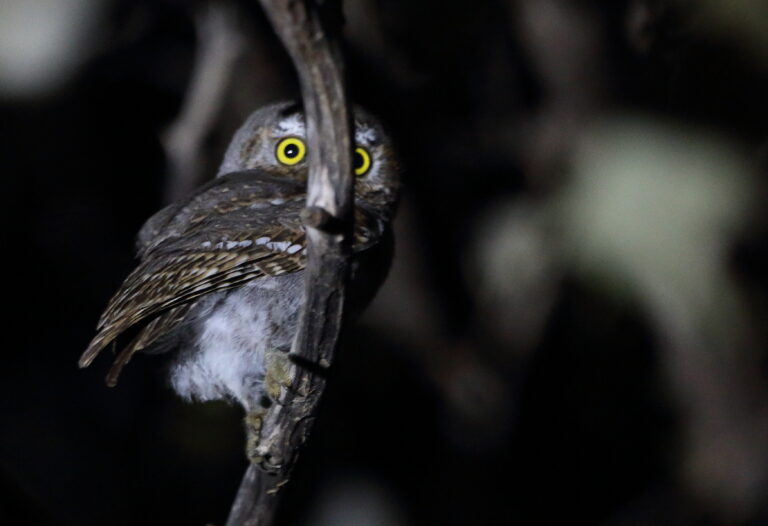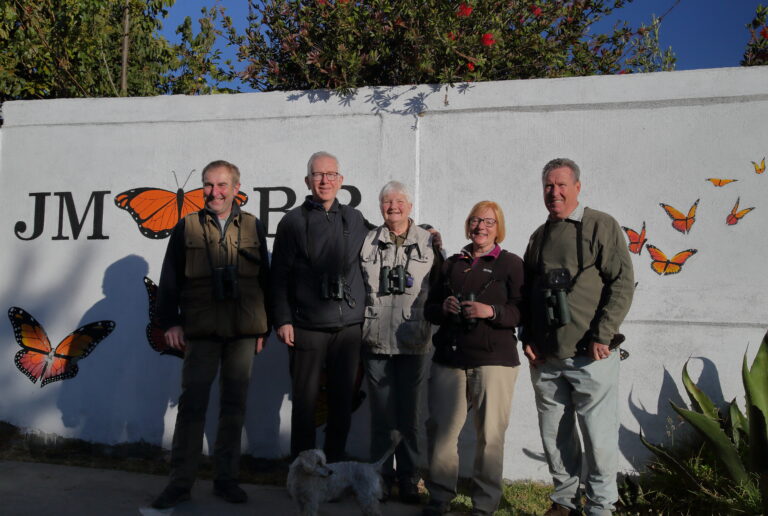
At Heathrow airport, it seems strange boarding a bus saying in lights on the front that our destination is Mexico! Once aboard the plane, our flight path seems almost as strange, as we head north over Scotland, west across Greenland and the desolate frozen wastes of northern Canada, and then south across the entire length of the USA, just like the amazing Monarch Butterflies we are travelling to see!
Driving west on the traffic-jammed roads leading away from sprawling Mexico City, we are soon heading along traffic free highways towards our lovely traditional guesthouse in the sleepy village of Macheros on the slopes of Cerro Pelón, a steep sided thickly forested extinct volcano. In and around the gardens of the guesthouse, we spot a plethora of interesting birds such as White-eared Hummingbird, Acorn Woodpecker, Bullock’s Oriole, Nashville and Townsend’s Warblers, Vermillion Flycatcher, Yellow-eyed Junco, Canyon Towhee, the scarlet-fronted House Finch and the sweetly singing Curve-billed Thrasher. After lunch, an afternoon stroll into the forest adjacent to the guesthouse adds more new sightings like Mexican Violetear, Orange-crowned Warbler, American Robin, Black-headed Grosbeak, the Goldcrest-like Ruby-crowned Kinglet and the busy Slate-throated Redstart; not a bad lot for a travelling day.
A pair of smart looking Grey Silky Flycatchers posing on a treetop before breakfast is a good start to the new day, where the productive lodge grounds also produce Hooded Grosbeak and Western Tanager right outside the breakfast room. After breakfast we visit the nearby Cerro Pelón Butterfly Sanctuary, where we meet up with a posse of horses and their minders for a trek up the mountain, gaining two thousand feet in height along the way. At the end of the trail, we find clusters of Monarch Butterflies clinging to the branches of Pine trees, like baubles on a Christmas tree and yet they’re so heavily laden that the branches actually bend under the sheer weight of so many butterflies! As the morning gradually warms up, the torpid butterflies slowly come to life, start flapping and take to the air. Eventually, shortly after midday, a myriad butterflies fills the air with an audible crackle as so many flapping wings beat in unison. By now the air is thick with millions and millions of these large majestic butterflies, cascading down the mountain in a virtual torrent, whereupon even the local guide, arms outstretched, is blown away by the spectacle! Back at the lodge, he tells us that we had witnessed one of the best shows of the season, and for me it was one of the most amazing wildlife experiences ever!
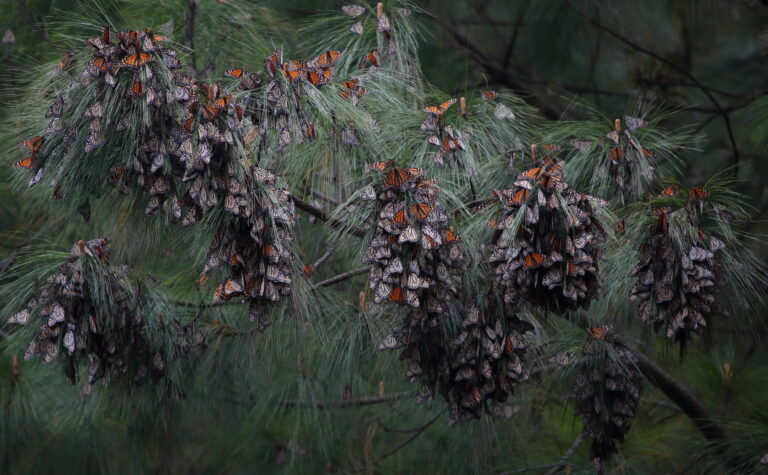
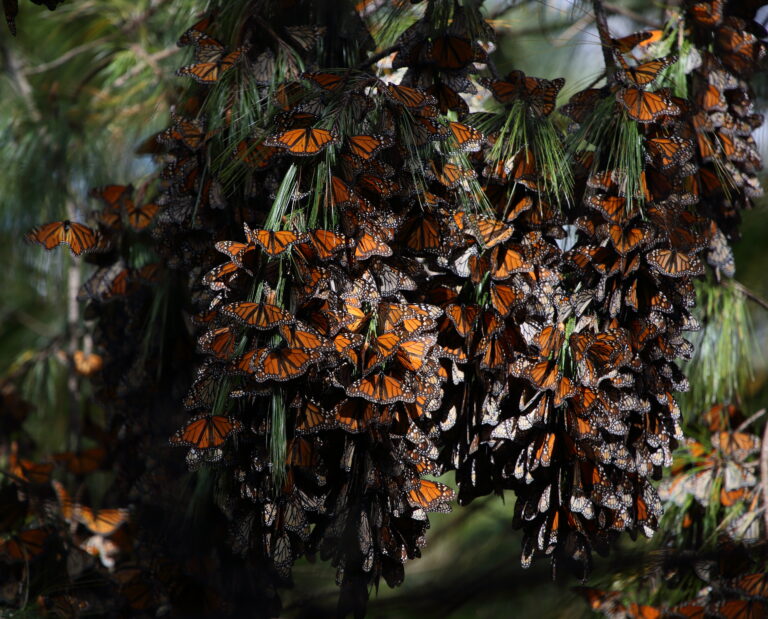
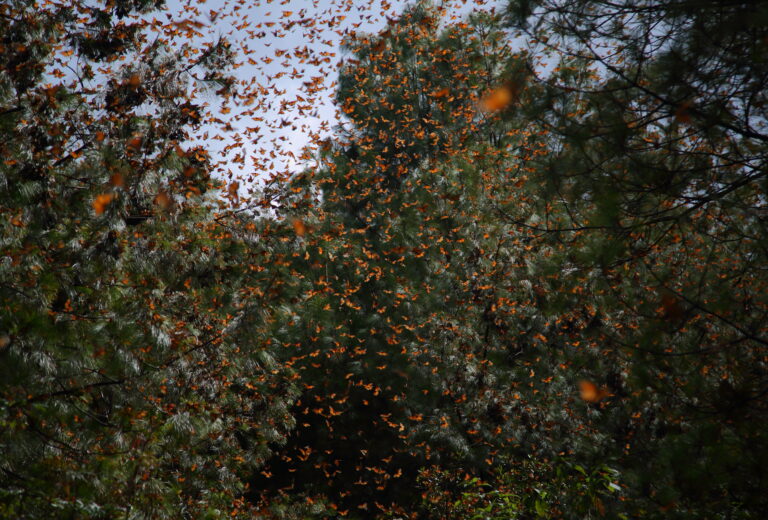
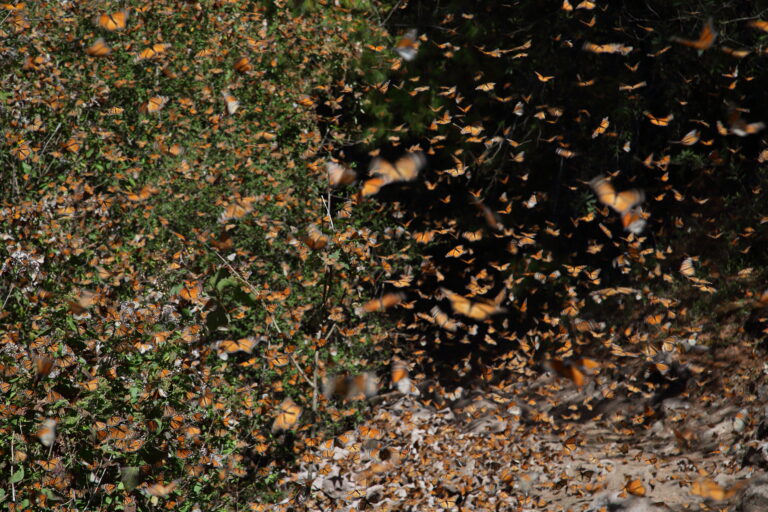
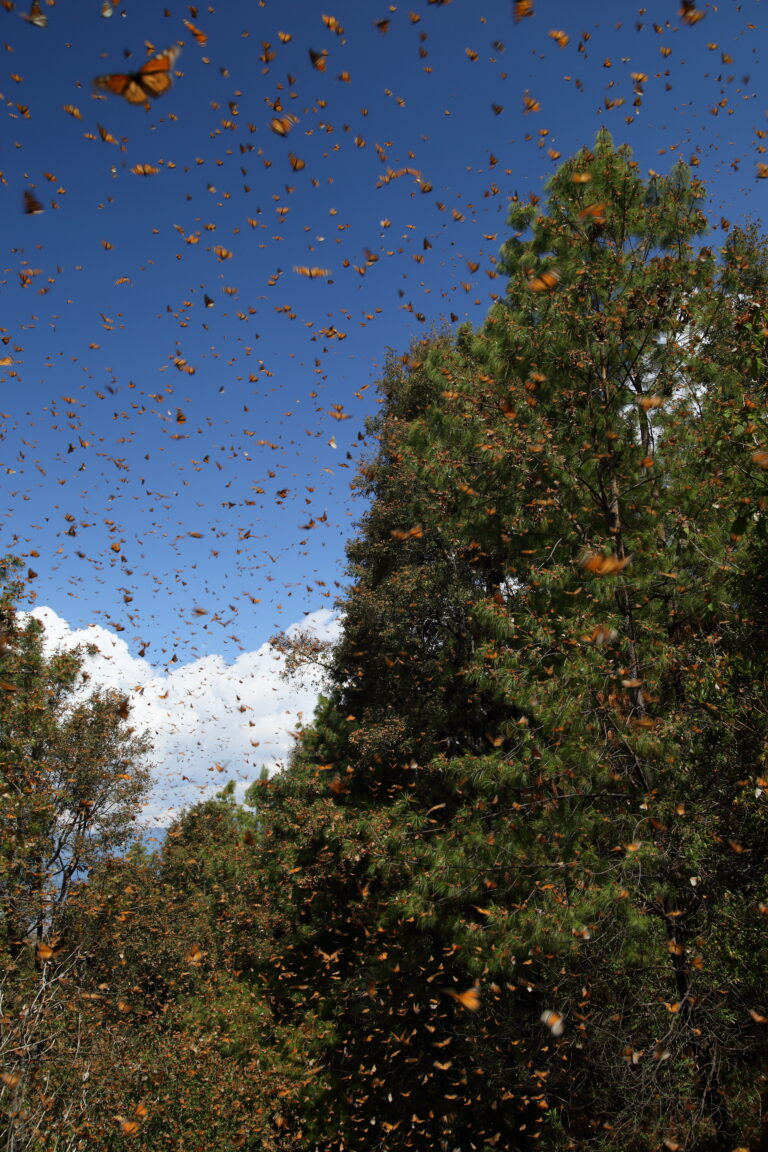
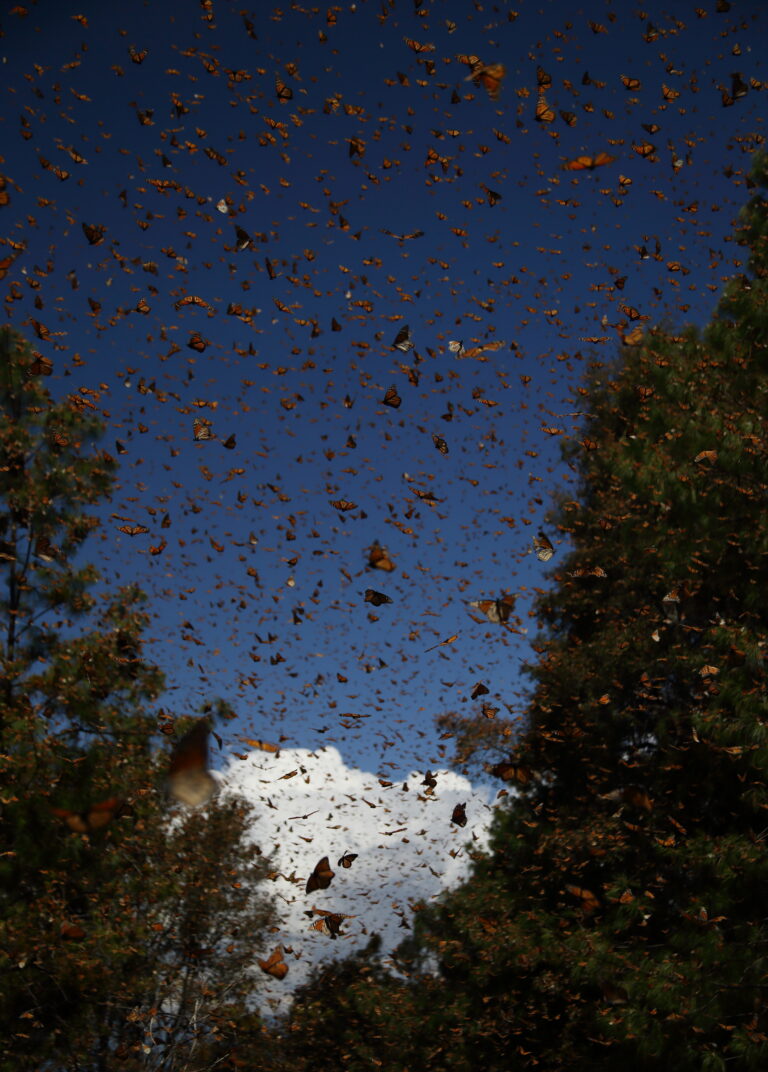
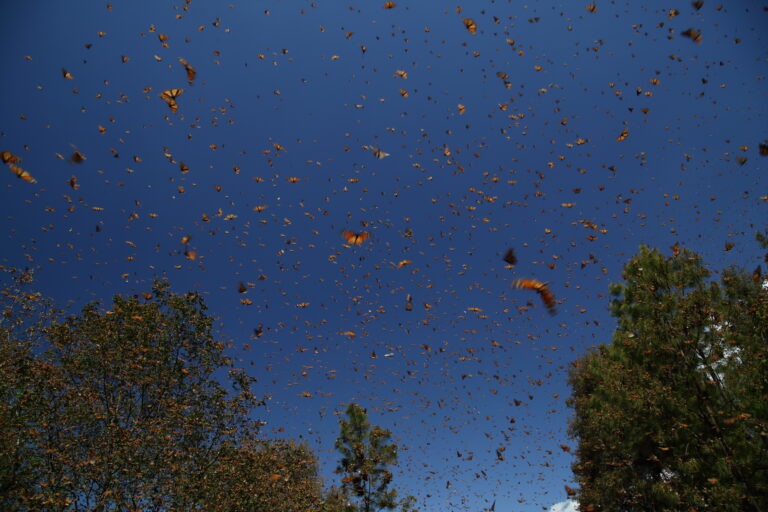
Back at the lodge, we spot Rose-breasted Grosbeak in the grounds, while a stroll into the nearby forest adds Eastern Bluebird plus Black-headed and Pine Siskins. What a memorable day that was, ending with a fabulous sunset.
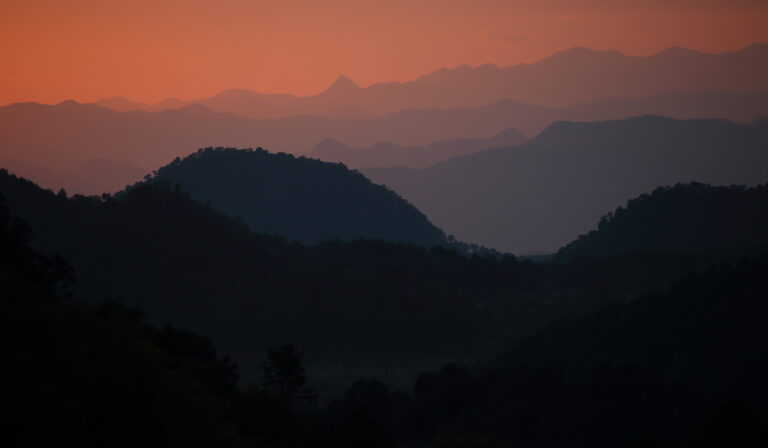
This morning we begin on the sun terrace overlooking the lodge grounds and the surrounding village, with a fabulous full moon setting behind the nearby mountainside. Many of the usual suspects like American Robin, Grey Silky Flycatcher, Bullock’s Oriole, Canyon Towhee and Acorn Woodpecker soon show up and we also enjoy scope views of Bewick’s Wren and Cassin’s Kingbird, both new for the trip, followed by Yellow-rumped Warbler (the Myrtle form) from the breakfast room and a Song Sparrow in the garden straight after breakfast. At 9am we set off on a drive to the El Rosario Butterfly Sanctuary, spotting Hepatic Tanager in the trees beside the entrance, where we mount up for a short horse ride through a lovely forest of towering evergreen Oyamel Fir trees, hearing the unmistakable song of Brown-backed Solitaire along the way. Once the trail levels out, we dismount for a short walk deeper into the forest which quickly leads to another amazing butterfly colony, and thanks to the experience of our local guide Joel, we arrive just as the densely packed clusters of butterflies are coming alive as the cool morning air reaches the critical 12.2 degrees Centigrade. In contrast to yesterday’s sudden torrent, today’s scenario is a less frenetic more tranquil scene as millions more of these deep cinnamon butterflies flash through the trees in gradually greater and greater numbers, creating a clearly audible rustling breeze as the butterflies spread out through the forest in search of a drink from small creeks; a mesmerising show and another truly remarkable and moving natural phenomenon.
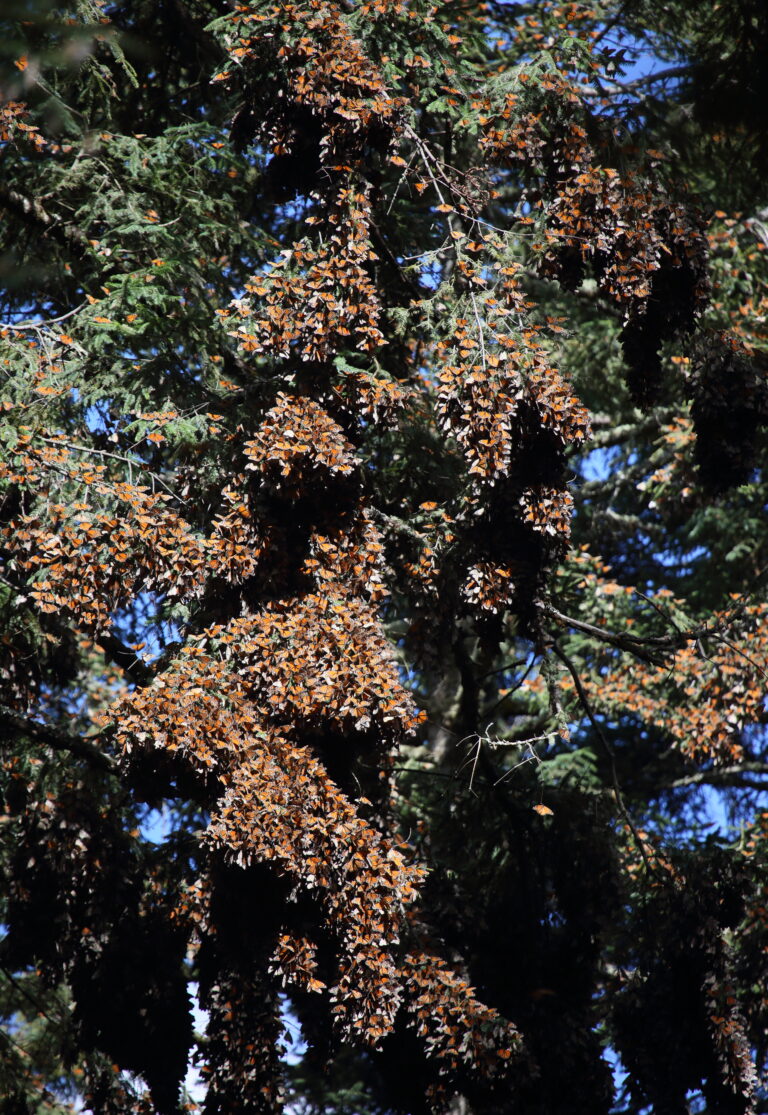
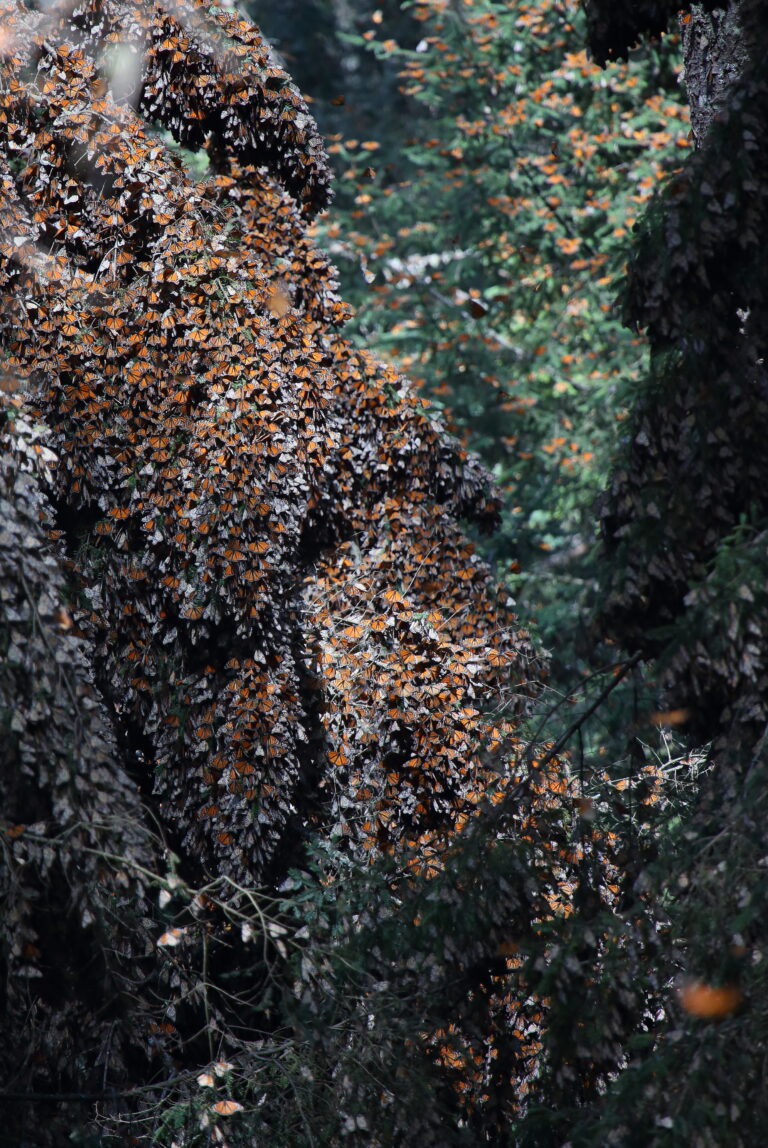
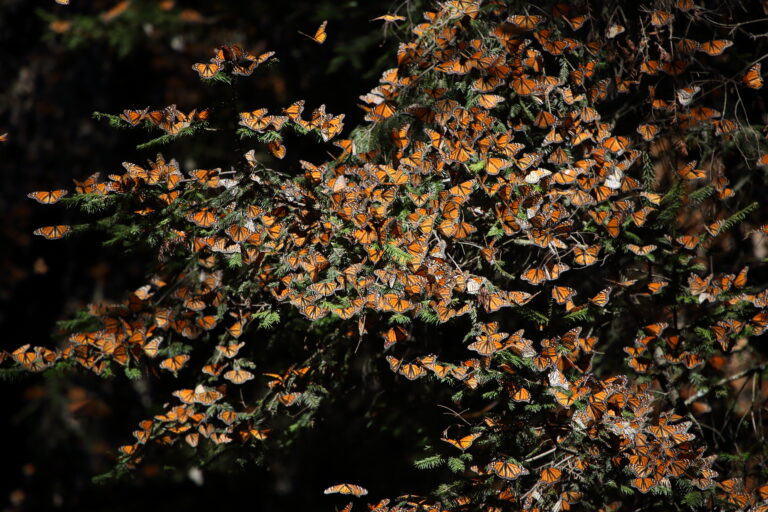
On the walk back down the trail we find the fabulous endemic Red Warbler, surely one of the best warblers ever!
This afternoon, back at the lodge we explore the local woods and track down another endemic, the Russet Nightingale-Thrush, followed by Tufted Flycatcher, Cinammon-bellied Flowerpiercer and the Spotted Towhee. Wowee!
Today, we drive back to Mexico City for an afternoon internal flight across the Sea of Cortez to La Paz, near the southern end of the long Baja California peninsula, where we meet our new guide Octavio and begin our Baja adventure with a lovely dinner in a local restaurant not far from the cathedral.
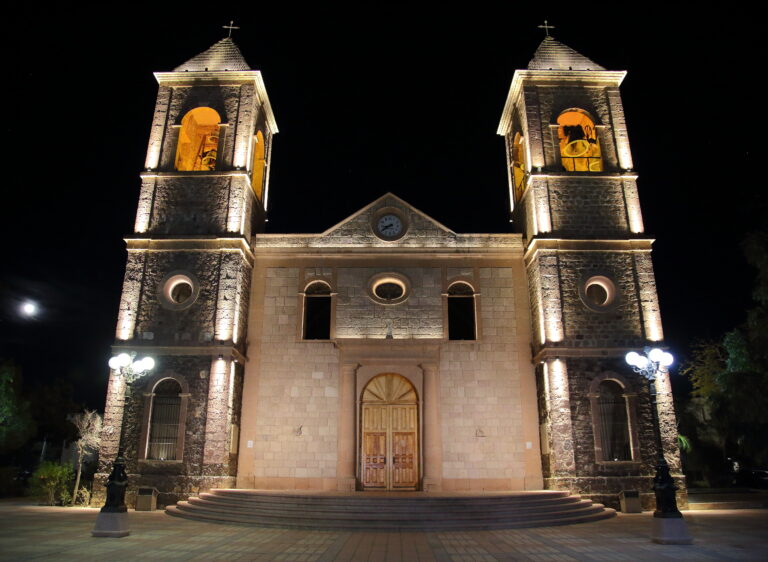
Stepping out from the hotel this morning, we spot a pair of Gila Woodpeckers in a tree across the street, along with White-winged Dove and a singing Lesser Goldfinch. With news that the port is closed due to high winds, our plan to swim with a Whale Shark and then cruise to Isla Espiritu Santo is scuppered, so we set off on plan B, which is a visit to nearby Balandra Bay where plenty of Turkey Vultures and the occasional Crested Caracara float across the clear blue sky, while a Northern Mockingbird amid the cactus scrub is new for the tour. The main event here is a sea kayaking trip, a new experience for some and part two of our birding ‘triathlon’, after mastering the equestrian event in the mountains, which was also a new experience for some in the group, so that’s two new skills on their CV’s! Paddling along the rocky shore we find a Spotted Sandpiper in immaculate winter plumage along with plenty of the more aptly named Yellow-footed Gulls. Next up are Brandt’s Cormorants, Brown Pelicans, Magnificent Frigatebirds and a colony of Blue-footed Boobies on a small rocky islet, with a couple of Brown Boobies amongst them. Once back at the beach we return to La Paz for lunch, with a stop along the waterfront to view a selection of shorebirds including Reddish and Snowy Egrets, Great Blue Heron, Ring-billed and Laughing Gulls, Caspian Terns and American Oystercatchers, with an Osprey soaring by offshore.
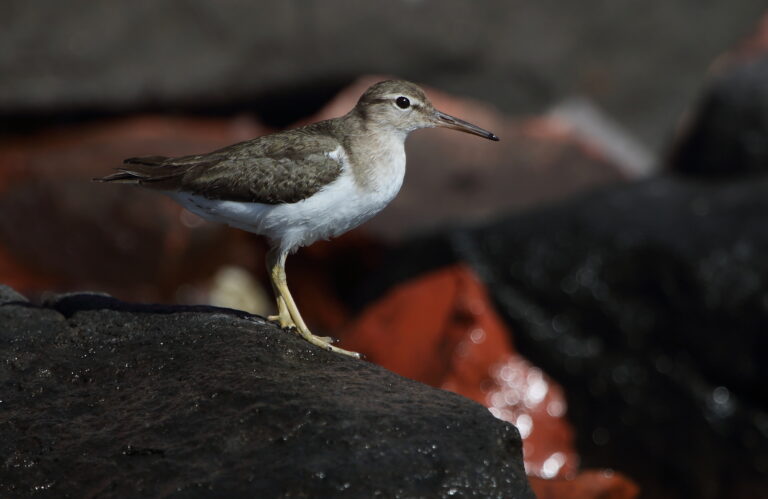
After lunch back in town, we head for the Ecoparque (aka sewage treatment facility) just out of town, where the pools are teeming with waterbirds such as ‘our own’ familiar Shoveler, Pintail and Black-necked Grebe, alongside the more exotic Least Grebe, Blue-winged, Green-winged and Cinnamon Teal, Lesser Scaup, Ruddy Duck, American Coot and White-faced Ibis, plus numerous waders like Spotted Sandpiper, Black-necked Stilt, and Long-billed Dowitchers, judging by their sharp “keek” calls. Besides the waterbirds, other sightings here include Common Ground Dove, Black Phoebe, Yellow Warbler, Hooded Oriole, Red-winged Blackbird, Savannah and White-crowned Sparrows, a flock of American Pipits and a circling Sharp-shinned Hawk, looking just like our own Sparrowhawk.
This morning we begin with a stroll along a track into the desert, through a lovely rock garden of succulent cacti, some as tall as trees. Early birds here include an Osprey on a bulky nest of twigs atop a telegraph pole, several Violet-green Swallows catching flies above the Tamarisk scrub, a trio of obliging Black-throated Sparrows and a very handsomely marked Lark Sparrow. Taking a botanical interest in a Mesquite bush, we suddenly realise we have a Greater Roadrunner sitting deep within the bush! After a close scrutiny from just a few yards, the pheasant-sized bird departs the bush and poses on a rock before doing exactly what it “says on the tin” and racing away along the track at speed. Moving on, further sightings include Ash-throated Flycatcher, California Gnatcatcher, Green-tailed Towhee and a Peregrine in an aerial dog fight with a Sharp-shinned Hawk. After an hour or so along the track, we hear the distinctive song of the Cactus Wren and spot it singing from the very top of one of the tall Cardón Cacti. Five minutes later, we notice that one of the many Turkey Vultures is actually a Zone-tailed Hawk, a vulture mimic which circles right overhead before sailing away. A pair of Ravens mob a Red-tailed Hawk and then we hear the Canyon Wren singing from a rocky slope above us and after a patient wait it actually performs its lively act from a rocky stage within ten yards of its audience!


After a very productive morning it’s time for lunch and suiting up for the final stage of our ‘triathlon’, the swimming event, with a Whale Shark! After yesterday’s wind the water is a little cloudy and the first attempt is a washout as the shark glides by with only a fleeting glimpse of its tail, despite its gigantic size. Back in the boat, we track the shark for a second go and as soon as we are in the water, the guide shouts “face down” in time for us to follow the huge tail directly below us, just a few feet deeper, and plastered with several Remora fish along for the ride. Wow, what an experience. On the third go we swim alongside the ‘sea monster’ virtually at arm’s length! By swimming at ‘full throttle’ I manage to keep up with it as it glides effortlessly along, propelled by a long swirling tail, but I resist the urge to touch as it’s not allowed. At such close quarters one can see the white ocellated markings on the darker body, plus five long gill slits and even the tiny eye, while a shoal of long silver fish ‘shadow’ the shark from below for protection from above. On the final go the shark swims straight toward the boat so that once we jump in the massive head and gaping mouth pass straight underneath just inches below me! What an amazing experience to be swimming alongside the world’s biggest fish, nourished solely by microscopic plankton! This is another awesome wildlife encounter, up there with the millions of Monarch Butterflies and one less thing on the ‘bucket list’!
Once back at the jetty, after a quick change, we have a full throttle white knuckle ride as we virtually fly across the sea to arrive at our beach camp on Isla Espiritu Santu in time for happy hour with the sea gently lapping on the sandy shore and Brown Pelicans sailing by across a beautiful sunset. We have arrived in paradise!
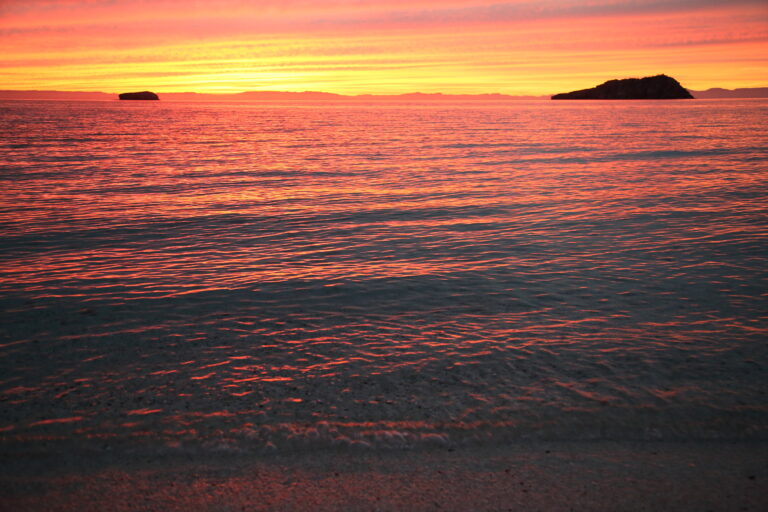
After breakfast on the beach we set off by boat to Los Islotes, an isolated clump of rocks, inhabited by Brown and Blue-footed Boobies, Brandt’s Cormorants and California Sea Lions, which gather around the boat as if waiting for us to jump in and play! Over the side we go to interact with the inquisitive and playful sea lions as they come at us like torpedoes before swerving away at the last possible moment. As well as the sea lions, we see a plentiful variety of colourful fish such as Moorish Idols, Yellow-tailed Surgeonfish, Rainbow Wrasse and Blue-chinned Parrotfish, so that it feels like being inside a giant aquarium!
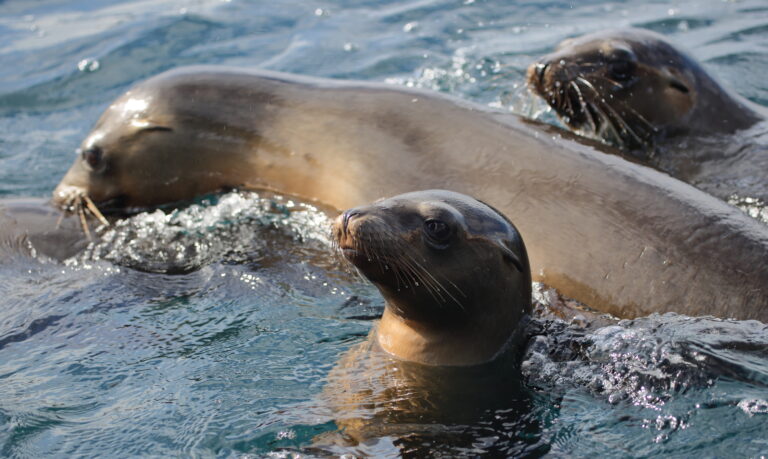
From here we return to camp via a small mangrove, hoping to see the Mangrove Warbler, a brown-headed sub species of Yellow Warbler. Within seconds of our arrival, there it is, showing really well at ridiculously close range; one of the easiest stake outs imaginable.
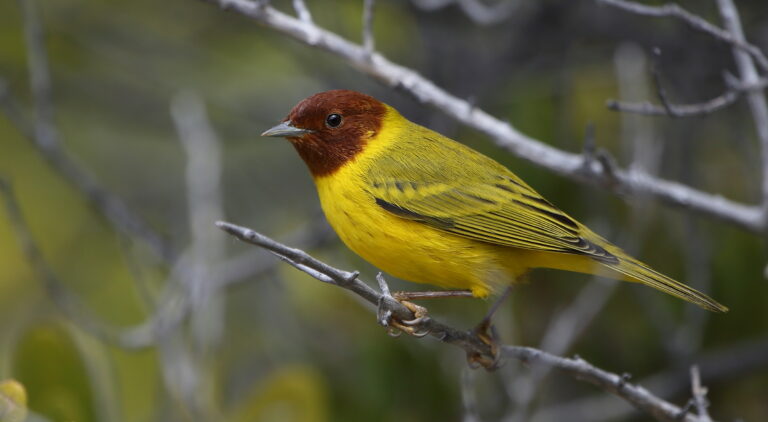
After lunch back at camp we head out in the boat again to a colony of around 600 pairs of Magnificent Frigatebirds, which fill the air. Among all the activity, several males display their inflated red throat pouches like balloons.
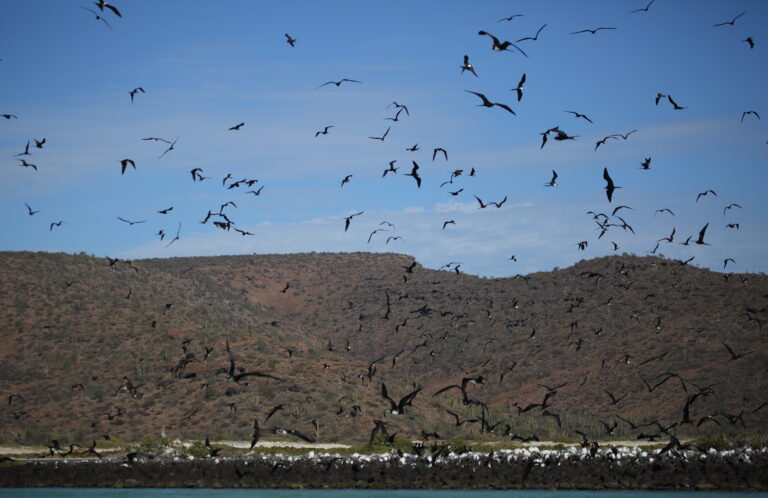
Next we head out into the Sea of Cortez, hoping for whales and seabirds but it is unusually quiet apart from some somersaulting Flying Mobula Rays, leaping well clear of the water!
Back at camp we enjoy another happy hour on the beach watching the sun set over the tranquil bay, while serenaded by a couple of rival Canyon Wrens.
With a wind blowing up overnight, yesterday’s gently lapping sea of tranquility is now bashing breakers onto the shore. Meanwhile the queue to board the boat from the beach, as we evacuate the camp looks reminiscent of a scene from Dunkirk! Once aboard, our ‘loco Capitán’ flies us back to La Paz at breakneck speed, as if on a mission with the Special Boat Squadron! At such high speed the spray creates a rainbow alongside the boat and with so much spray we are soon completely soaked and so we would have been better off wearing our wetsuits which are ironically nice and dry in the luggage! After this battering cruise back to the mainland, and a quick change into dry clothes, we head north along route 1, through a desert of tree-sized Cardón Cacti, to Puerto San Carlos on the shore of Magdalena Bay, where White Ibises and Semipalmated Plovers are new for the trip.

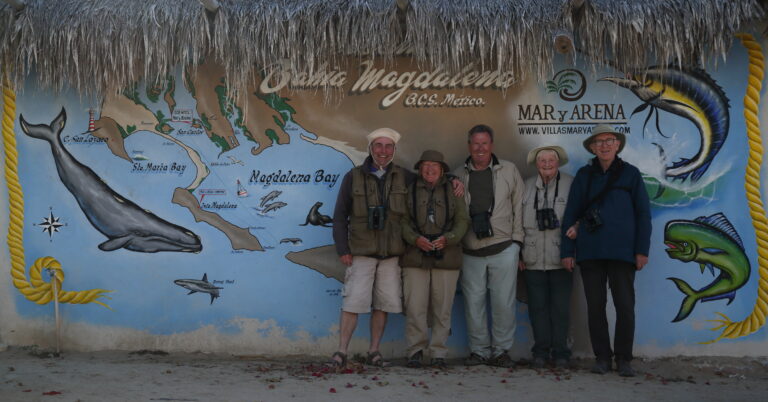
After lunch, we board a small boat called a Panga, for a cruise on Magdalena Bay. The mangroves along the shore here bristle with members of the heron family including Snowy, Great and Reddish Egrets and Little Blue, Great Blue and Tricoloured Herons, while the sand bars are covered with numerous Western, California and pure dark chocolate immature Heermann’s Gulls alongside shore birds like Marbled Godwit, Long-billed Curlew and Willett. Heading to the mouth of the bay we spot several Black-vented Shearwaters and then the spouts of whales start shooting up in different directions. There must be several whales around but it’s impossible to say how many and eventually we see the arching backs and occasional tail flukes of several dappled Grey Whales.

This morning we set off in the Panga, but just before boarding, a couple of Western Scrub Jays make a timely appearance. Once out on the bay, we spot a single Black Brant and then the first of many Grey Whales, spouting, breaking the surface with their arching backs and trailing tail flukes and occasionally waving a flipper. Some of this whale action is at very close range, allowing us to track the courses of their long pale grey forms under the clear blue water right alongside the Panga!
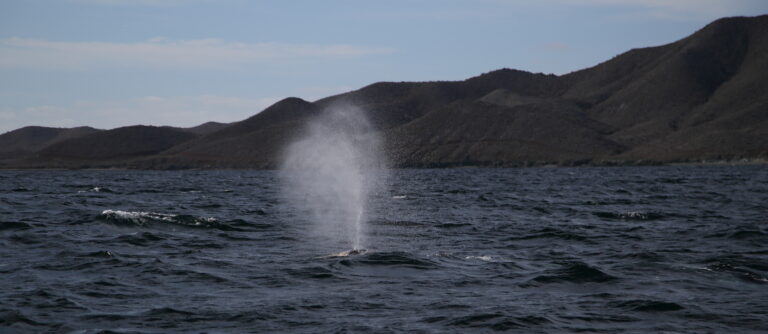

After a picnic lunch on a deserted beach we slowly head back to base, spotting an Arctic Skua and then a group of orange-billed Royal Terns resting on a beach, with a larger red-billed Caspian Tern for a useful comparison. Along the sand dunes which separate the bay from the Pacific Ocean we also spot a pack of four Coyotes patrolling the beach, while a raft of around 150 Black-necked Grebes is very busy diving not far from the boat. Back at the jetty we spot a smart looking adult Heermann’s Gull amongst all the immatures in their dark chocolate plumage.

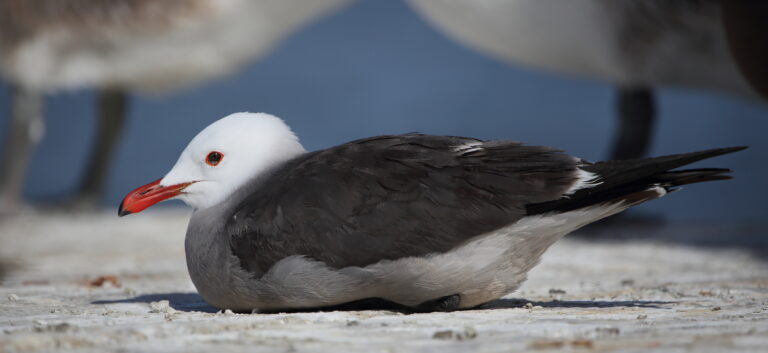
Back at the hotel, within yards of two Osprey nests, we enjoy a waderfest along the shore, spotting Whimbrel, Willett, Marbled Godwit, Greater Yellowlegs, Wilson’s and Semipalmated Plovers and one of the Dowitchers, along with White Ibis, Reddish, Snowy and Great Egrets, Tricoloured Heron and a Yellow-crowned Night Heron snoozing in a Mangrove bush.
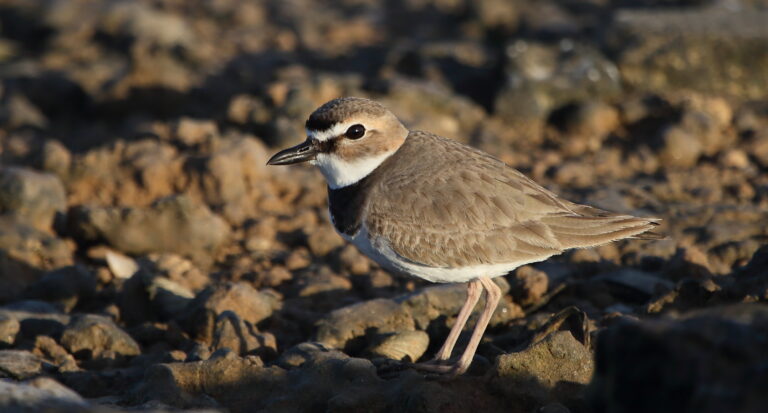
It’s too windy for boats on Magdalena Bay this morning so we head north to a more sheltered coastal lagoon, spotting numerous Loggerhead Shrikes sitting high on the tips of Cardón cacti along the way. Once at the lagoon we board a Panga and despite the windy conditions we see numerous Bottlenose Dolphins and plenty more Grey Whales at close range, including a male following a female and a mother and calf, but the choppy sea is not conducive to any ‘heavyweight petting’. Meanwhile, the abundant birdlife includes flighty Belted Kingfishers, a juvenile Peregrine sitting on a mud bank, a group of about twenty American White Pelicans, a flock of Black Brant all the way from Alaska, just like the Grey Whales, and a couple of ‘washed out’ first winter Glaucous-winged Gulls amongst a motley crew of Herring, Western and California Gulls.
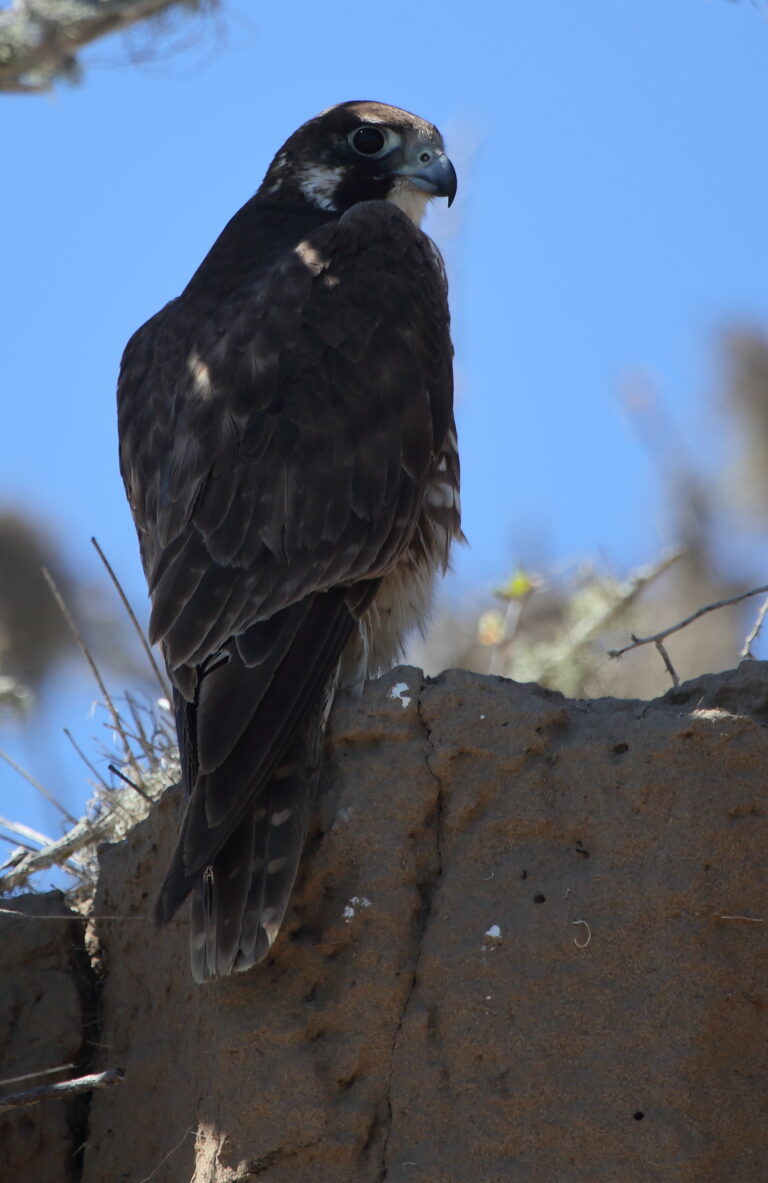
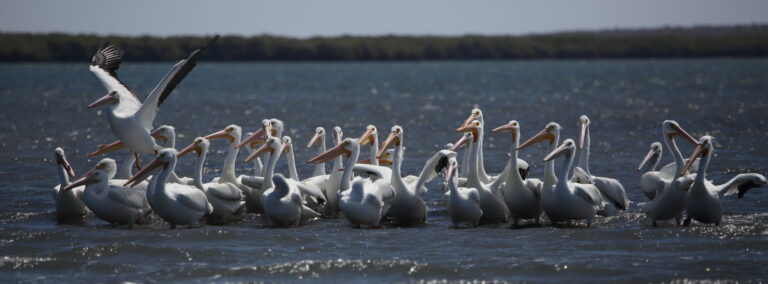
On the drive back to Puerto San Carlos, a brief roadside stop in the desert produces Gila Woodpecker, Gilded Flicker and a Killdeer, which is normally more at home along the seashore.
The wind is blowing stronger than ever this morning as we begin the journey south through a seemingly endless desert of Cardón cacti where a brief roadside stop produces good views of Western Scrub Jay and Gila Woodpecker. We arrive at Todos Santos in time for lunch in the lovely garden of a superb restaurant where the endemic Xantus’s Hummingbird joins us by feeding from the flowers of a succulent just a few feet from our table! Once installed at the fabulous Casitas Colibris, with a beautiful view overlooking a coastal lagoon and the Pacific beyond, a fruitful walk produces well over twenty species including Red-tailed and Sharp-shinned Hawks, Green Heron, Least Sandpiper, Common Ground Dove, White-winged Dove, Gilded Flicker, Northern Mockingbird, Cactus Wren, Black Phoebe, Ash-throated Flycatcher, Orange-crowned Warbler, Scott’s and Hooded Orioles, House Finch, Black-throated and Chipping Sparrows and the tiny smart Verdin, plus White-tailed Antelope Squirrel and a spouting Humpback Whale! We must also make a special mention of a couple more Xantus’s Hummingbirds, a Grey Thrasher posing on top of a cactus and the secretive Belding’s Yellowthroat, showing well from its dense hideout in the reeds around the edge of the lagoon. That’s three Baja endemics in one afternoon!

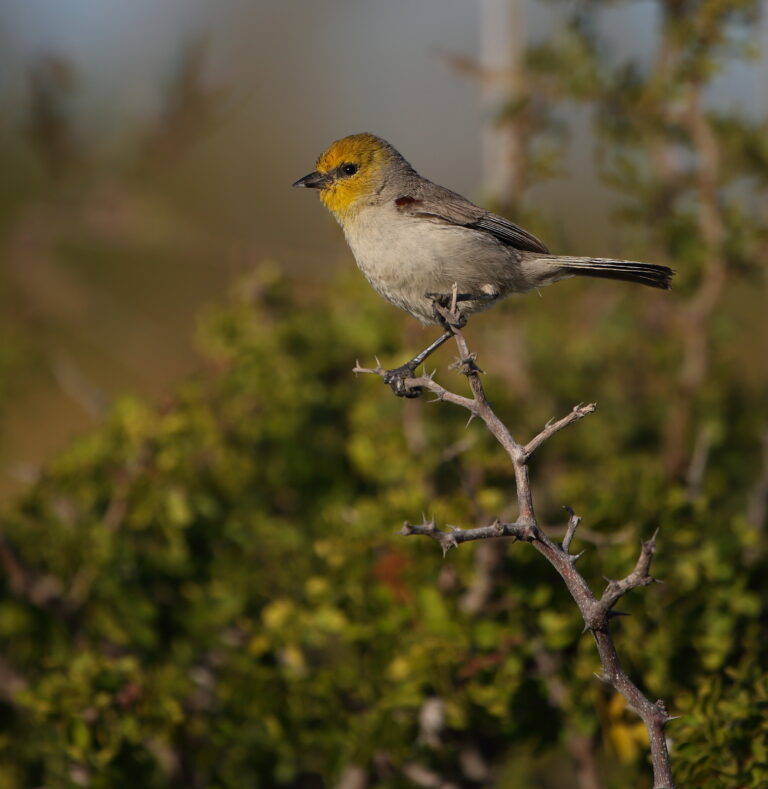
This morning we leave Las Casitas Colibris and head south for a stroll along a desert track where we soon add new birds to the list like California Towhee, Ladder-backed Woodpecker and the superb male Northern Cardinal with a vertical punk-style crest, while a handful of California Quail dashing across the track is a very lucky sighting. A bright yellow and black Scott’s Oriole entertains us from the top of a tall cactus with its lovely sweet song, followed by a frog chorus amid the palm-filled oasis near the beach, where a reed bed produces another Belding’s Yellowthroat. At the deserted beach, a solitary Spotted Sandpiper is joined by a Green Heron, which then decides it’s not such a good idea to be out in the open and dashes back to cover.
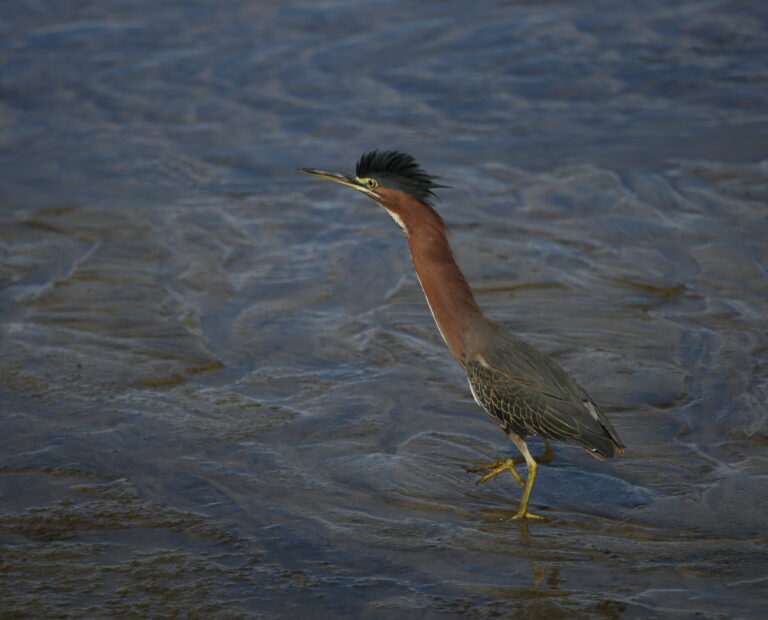
Moving on we follow a rough dirt road into the Sierra de la Laguna, spotting Cooper’s Hawk, perched on the top of a nearby Agave. Further on a brief stroll is very productive with old favourites like Loggerhead Shrike, Western Scrub Jay and Northern Cardinal and new birds like Pacific Slope Flycatcher, Blue-grey Gnatcatcher and a pair of crested Phainopeplas with deep red eyes. After a very bumpy ride we arrive at our camp up in the cool sierra in time for a delicious chicken stew lunch.
This afternoon a stroll near the camp produces new birds like Bell’s and Warbling Vireos, Wilson’s and neatly marked Black-throated Grey Warblers and the Chaffinch-like Lazuli Bunting.

It’s our last day in the field and we set off on a long hike up into the scenic wooded sierra, where we find a colourful variety of butterflies such as the White-tipped Metalmark as well as now familiar birds like Ladder-backed and Gila Woodpeckers, Western Tanager, Scott’s Oriole, Western Scrub Jay, Bell’s and Warbling (should be wheezing) Vireos, Orange-crowned and Black-throated Grey Warblers, Ash-throated and Pacific Slope Flycatchers, Blue-grey Gnatcatcher and Lazuli Bunting, followed by a well earned cold beer and a nice warm shower.
After dinner, we make one last salida from camp in search of owls under a clear starry sky, and our local guide Maria soon hears the calls of the Elf Owl, but in the darkness it seems unlikely we could possibly find, let alone see, such a small bird amongst all the vegetation. Nevertheless Maria seems confident as the calls gradually sound closer and closer. Suddenly she points up to the nearest bush and there it is, the tiny Elf Owl, probably the world’s smallest owl, weighing less than 1.5 ounces, starring at us with its big yellow eyes, barely twenty feet away! Definitely a contender for bird of the trip, and a great way to end such a fabulous tour, packed with so many brilliant highlights.
